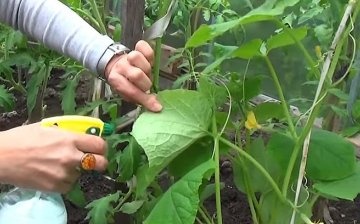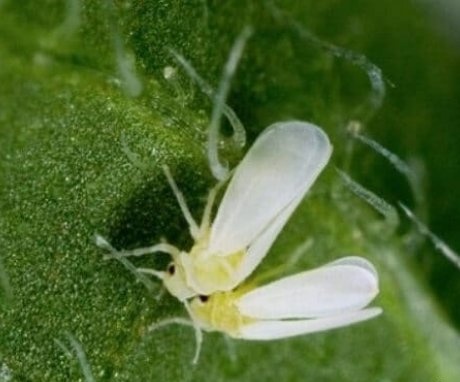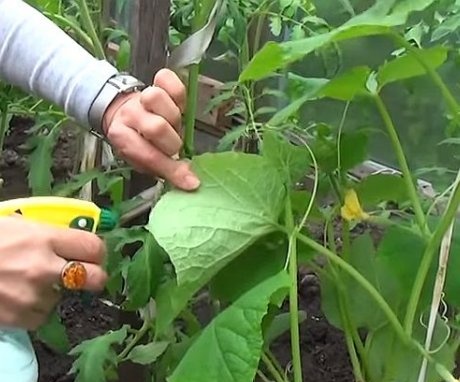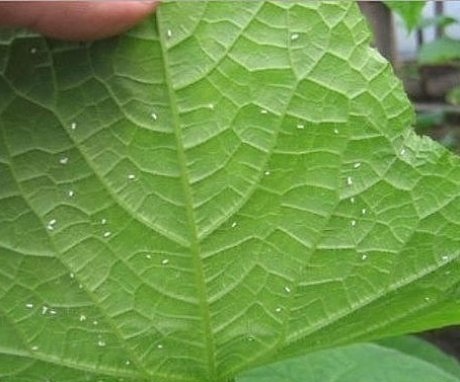Causes of the appearance of whitefly on cucumbers and effective methods of dealing with it
Every year, gardeners and greenhouse owners complain that they did not manage to harvest the expected cucumber crop due to the influence of pests. One of the most insidious is the small white midge called the whitefly.
This butterfly hides on the back of the leaf, sucking out the sap of the plants. It is necessary to regularly inspect the leaves of cucumber bushes in order to prevent the massive spread of the whitefly.
If a whitefly is found on cucumbers, you must immediately fight it until it causes tangible harm to the vegetable.
What is this pest
Whitefly is a very small white butterfly that parasitizes cucumbers and other vegetable and ornamental crops. The length of an adult insect barely reaches 2 mm. Whiteflies are capable of walking with their paws and can fly from one plant to another.
The insect's life span is limited to 2-3 weeks, but during this short time period, the female manages to lay about 100 eggs. After 9-12 days, a larva appears from the laid eggs, which needs to go through 4 life phases before turning into an adult insect. The laid butterfly eggs can be found on the back of the leaf. Larvae and adult insects are also constantly found there.
The habitat of the pest on the back of the leaf adds complexity to the fight against it. The larva hatched from the egg is called a nymph. She retains the same name, passing into the second, and then, and into the third phase of development. Outwardly, the nymphs are tiny yellowish scales with red eyes. The body of the nymphs has thorns.
When the nymph enters the fourth phase of the cycle, she begins to move on her paws. In a few days, it becomes an adult insect and begins to reproduce. Of more than 60% of the eggs, female individuals hatch, each of them can give up to 12 generations during a calendar year.
Depending on the available conditions, the insect goes through 5 stages of its development in 20-28 days. Due to such a cyclical development, it is very difficult to fight this butterfly in a greenhouse.
What does it look like
Outwardly, the insect resembles a house moth, but only much smaller in size. The color of the wings and abdomen is white with a yellowish tinge. The average length is 2 mm.
Insect eggs are light green, their size does not exceed 0.2 mm. It is almost impossible to see them with the naked eye. Over time, the clutch changes color to brown, and then yellow-white larvae emerge from the eggs. Nymphs constantly drink cucumber juice, grow rapidly, moving to the next age groups, until they turn into an adult insect.
Damage to cucumbers
Despite the small size of butterflies and even smaller size of their larvae, the harm on cucumbers from the whitefly can be very great. Here's what happens to whitefly-infested cucumbers:
- when the whitefly sucks the juice, the plant weakens, its leaves fall off;
- the pest damages the inflorescences, as a result of which the number of ovaries decreases;
- the butterfly, in the process of vital activity, secretes a sticky sweet liquid, on which a sooty fungus settles;
- this sweetish liquid also attracts other pests, including ants;
- with a massive defeat, the cucumber bush dries up.
Signs of damage to cucumbers
If a whitefly has started up on cucumbers, the following signs will indicate its presence:
- small white midges flying over cucumbers;
- whitish dots on the leaves;
- sticky substance on cucumbers;
- leaves begin to fade, curl and wither;
- the appearance of yellow spots with indistinct boundaries;
- larvae on the back of the leaf plates;
- inhibited development of cucumbers;
- shedding of leaves by a plant.
Methods for dealing with whitefly on cucumbers
As we have already noted, the beginning of the resistance to the pest should be immediately after its detection on cucumber plants. Delay in this matter will result in a big loss of the harvest of zelents. The modern vegetable grower has a large selection of effective techniques and tools, thanks to which you can remove the whitefly.
Mechanical (+ traps)
This method is the simplest and can be effectively applied on cucumber plantations where isolated insects have been found. Its essence lies in the manual collection of butterflies, knocking them down with a stream of water or wiping the stems and leaves with a soapy water solution.
However, the benefits of this option are minimal and temporary. It is problematic to catch all butterflies and their nymphs, and individuals knocked down by water after a while will again rush up. It is much better to make or buy special traps and apply them in practice.
Better yet, use purchased orange sticky traps against butterflies. They are sold in the form of long strips or rectangular pieces of thick paper with a sticky mass applied to them. Insects mistake orange for a light source, fly towards it, sit down and stick forever.
It is easy to make such a trap yourself using the following algorithm:
- we take petroleum jelly, castor oil, rosin and mix these ingredients in equal proportions;
- before mixing, the rosin must be melted in a water bath, and then add castor oil with petroleum jelly and a little honey to it;
- after cooling the mixture, apply it to thick paper;
- we hang the paper with a sticky composition among the cucumber plants.
Important! The mechanical method will not eliminate the re-colonization of cucumbers by the whitefly. Eradicating butterflies will require a more serious approach.
Chemical
With a massive defeat of the bushes by the whitefly, the best effect in the fight against it will give purchased chemicals called insecticides. Usually they are used by spraying the ground part of the plant. The following drugs have proven themselves most well:
- Aktara;
- Decis;
- Fufanon;
- Admiral;
- Akarin;
- Aktelik.
For better adhesion, 50 g of household soap is added to the bucket of solution. Thanks to this, the drug will stay on the leaves of cucumbers for a long time. It is highly undesirable to exceed, during treatments, the recommended dose of the agent, as well as the number of its applications per season. This will negatively affect the development of the plant.
Biological
Under natural conditions, the whitefly has a lot of natural enemies. On the use of these beneficial insects and microorganisms, a biological method is built to combat this butterfly. Here are the options for fighting:
- Application of encarsia. This is an insect that parasitizes whitefly eggs. In the greenhouse, the pupae of the encarsia are laid out at the rate of 5 pcs. per m2. After a certain period of time, pupae turn into adult insects, begin to reproduce, destroying whiteflies.
- Release of lacewings and ladybirds. These insects eat butterflies and their eggs. Due to this, the population of the pest of cucumbers is greatly reduced.
- Place calendula or marigolds among the cucumber bushes. These plants emit a specific odor that whiteflies cannot tolerate.
- Treat cucumber bushes with Verticillin. This is such a remedy, the active ingredient of which is a fungus, which destroys the whitefly.
Attention! Biological agents give a good result if there are not many whiteflies on the cucumber bushes.
Folk
When cucumbers are affected by whitefly, one of the folk remedies can be used. Thanks to spraying the bushes with home remedies that are always at hand, it is also possible to solve this problem. The recipes for the most popular folk remedies are presented below.
- Soap. Laundry soap can eliminate whitefly butterflies. The procedure is performed like this:
- one hundred grams of soap is ground on a grater;
- dilute it in 6 liters of heated water;
- the resulting solution is sprayed weekly on the vegetative part of the plants.
- Yarrow. You will need fresh leaves to get the solution. It is necessary to finely chop 100 g of leaves and pour 1 liter of water. The composition is subjected to infusion for 46 hours and, after straining, it can be sprayed weekly on cucumber bushes.
- Garlic. It has been established that garlic, with its pungent odor, scares off adult whitefly butterflies well and has a detrimental effect on their larvae. Garlic-based recipe is prepared according to the following algorithm:
- chop 100 g of garlic cloves;
- pour the resulting gruel with 500 ml of water;
- we insist in a shaded place for 80 hours;
- we filter the composition;
- we dilute 5 g of garlic infusion with 1 liter of warm water;
- spray the bushes.
- Dandelion. This plant is used to treat the inflorescence and rhizome. The recipe is prepared like this:
- wash the plant with warm water;
- it is passed through a meat grinder;
- the resulting gruel is poured into 1 liter of water;
- insist composition 80 hours;
- filter;
- sprayed on cucumber bushes.
- Tobacco. To do this, pour 1 liter of heated water over a pack of Prima cigarettes, and then infuse it for 5 days. After straining, the solution can be used for spraying bushes.
- Vinegar. A recipe based on this product is prepared very quickly. We must take 1 tbsp. l. table vinegar and dilute it in 1 liter of water. Cucumber bushes are treated with a ready-made solution by spraying from a spray bottle.
- Celandine. Take 260 g of celandine leaves and fill them with 3 liters of water. After the composition has been infused for 2 days, it can be used to spray whitefly bushes. A similar treatment can be duplicated after a week.
Nuances of fighting whitefly in a greenhouse
When a whitefly is detected on cucumbers in a greenhouse, you need to immediately think about how to get rid of it faster. You need to hurry because the greenhouse for this butterfly has all the conditions for life and rapid reproduction. In a short period of time, the female insect will give several generations and then it will be even more difficult to destroy the pest.
You can get rid of the whitefly pretty quickly by using a commercially available insecticide. After 2-3 treatments with an interval of 10 days, the butterfly population is completely destroyed. Next, you need to think about preventive measures to prevent a repeated attack by the pest.
The list of autumn preventive work in the greenhouse aimed at preventing whitefly:
- Emptying the greenhouse. After harvesting, remove all plant residues, objects of labor, mechanisms from the greenhouse. Put a film on the greenhouse soil and start disinfecting internal structures.
- Disinfection of structures. When processing, it is important to pay attention to all hard-to-reach places where the pest can hide. As a disinfectant, a chemical is used that can dissolve the integumentary membrane of the whitefly egg. To do this, you can apply the following tools:
- creolin solution;
- an aqueous solution of technical alcohol or vodka in a 1: 1 ratio.
- Repeated disinfection. After 3 days, it is desirable to re-disinfect the greenhouse structures. This time it is necessary to apply the insecticide Aktaru. This preparation will destroy the surviving adult butterflies and nymphs after the first treatment. All types of chemical treatments in the greenhouse must be carried out in personal protective equipment. For spraying, you should choose the evening hours.
- Soil disinfection. It is known that the whitefly cannot live in an alkaline environment.In this regard, the soil must be dug up in the fall and lime or ash must be added to it. If lime is used, the application rate is 150 g per m2. If ash is used for alkalization, then it is enough to add 3 glasses per m2.
- Greenhouse fumigation. Purchased smoke bombs with insecticide are used. If it was not possible to purchase checkers, fumigation with sulfur is carried out. For this, trays with sulfur are laid out over the entire area of the greenhouse and the product is set on fire. When sulfur burns, a poisonous gas is released - sulfuric anhydride, which kills all living things around. Before fumigating, you need to seal all the cracks in the greenhouse so that the gas does not escape. After 2 days, the greenhouse is well ventilated.
- Freeze the greenhouse. In winter, when the frost is minus 15 degrees or more, the heating in the greenhouse is turned off, and the doors and vents are wide open. In such a frost, all nymphs and adult butterflies will die.
In the open field
Vegetable growers use for cucumbers in the open field from whitefly folk remedies and purchased insecticides. More often, preference is given to natural homemade preparations, since they are environmentally friendly.
Folk remedies
Folk ways to destroy whitefly:
- Ammonia. This product shows effective whitefly performance. Add 50 ml of ammonia and 25 g of liquid soap to a bucket of water. Such treatments can be carried out twice a week until all the butterflies on the cucumbers have disappeared.
- Ash. The following recipe is prepared on the basis of wood ash:
- pour a glass of substance with 5 liters of hot water;
- mix the composition and leave it for 5 hours;
- add 50 g of crushed laundry soap and mix everything again;
- use a solution for spraying cucumber bushes.
- Tar soap. On a small area, tar soap can be used against the whitefly. The recipe is prepared like this:
- a bar of soap is rubbed with a grater;
- pour 1 part of soap with 6 parts of water;
- the composition is mixed and whipped until foam is obtained;
- apply foam to the stems and leaves with a sponge.
Important! In addition to the above recipes, you can use infusions and decoctions of garlic, dandelion, tobacco, yarrow, or the mechanical traps described above.
Purchased drugs
The following whitefly insecticides are often used outdoors:
- Fitoverm;
- Aktara;
- Spark.
All of these chemicals are very effective and allow you to exterminate any population of butterflies in a short time. However, in comparison with treatments in a greenhouse, the preparation is less stable on plants. The action of the drug can be interfered with by such weather phenomena as rain, fog, dew; strong wind, heat.
In this regard, a greater number of treatments may be required than in protected ground. When diluting an insecticide for outdoor treatments, always add soap to the solution for better adhesion. Treatments should be done early in the morning or late in the evening.
Prevention of the appearance of whitefly on cucumbers
When growing cucumbers, it is not enough to destroy the whitefly once, you still need to perform a number of measures in order to prevent its reappearance. Here is a list of measures to reduce the risk of whitefly affecting cucumbers:
- carefully check the purchased soil, materials and objects that you use in the garden and in the greenhouse for the presence of whitefly larvae;
- after harvesting, collect and remove all plant residues outside the garden;
- use glue traps throughout the growing season;
- during the growing season of cucumbers, do not allow weeds to overgrow the site;
- do not lay the compost heap in the greenhouse;
- keep the soil loose throughout the season;
- in the fall, disinfect the soil with a solution of copper sulfate.
Whitefly on cucumbers is a big disaster, it is capable of inflicting great damage on the crop of zelents in a short period of time. If signal signs of defeat are detected, it is necessary to immediately engage with it.There are a lot of ways to destroy the pest, you just need to choose the appropriate one.
Watch a video on how to properly deal with a whitefly:











